
| HOME ABOUT APHEX CABLES CRYSTAL FREQ CHART SURROUND TEST CD WHITE PAPERS PROJECTS |
| Project 1139 Spatial Dipole speakers, SVS 3000 subs, corner DIY bass traps, stunning results |
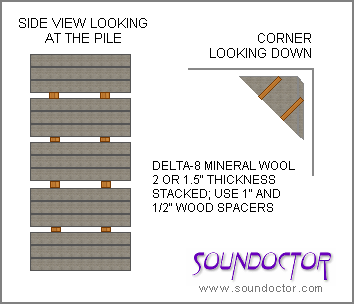 |
|
| DIY Corner bass trap |
THE CUSTOMER PREMISE
In addition to hiring me to advise on products, adjust the system and integrate the subs, this customer decided he wanted some corner bass traps but he wanted to build them himself. Based on previous experience with Delta-8 Mineral Wool, I came up with this DIY scenario. I like it because it's easy to work with, is WAY less disturbing to your skin than fiberglas, and lower in cost. You can cut it with a long blade carpet knife, a kitchen bread knife, or a table saw.
THE ACOUSTIC PROJECT
The idea here is simple. Make a 3/4" plywood triangle on the floor, push everything tight into the corner, stack the pieces up and insert wood spacers. I initially suggested both 1/2" and 1" spacers but simply using the 1" ones seems better. You can space every 2 or 3 sheets. Then you place another wood triangle on top, and attach vertical furring strips to all the spacer bars to stabilize everything. Then when you are all done, and the assembly is stable enough to move, you pull it AWAY from the corner about 3-4".
You then can affix a cover cloth such as inexpensive burlap from a fabric store or Guilford Of Maine acoustic cloth in your choice of industry standard colors (that all the regular acoustics companies use).
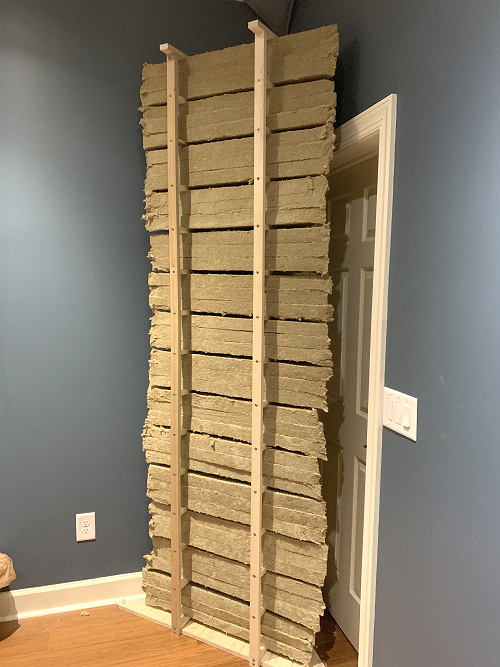 |
|
| The corner bass trap about halfway finished |
So here we are on the way to being finished.
Don't get me wrong — there are many fine acoustics companies that make both corner traps and "panels", but this customer was retired and clearly wanted to experiment.
Here's my convenient
and very complete list of "acoustics":
www.BostonAudioSociety.org/links3.htm
Note that since everybody always asks me about "panels", the companies that make panels are indicated. Check out this STUNNING solution: www.EzoBord.com (I am a dealer for them)
Be aware that different companies ideas of what constitutes a "bass trap" varies widely. If you have a problem in your room at 30 or 40 Hz buying an ineffectual bass trap that really only goes down to 70 or so is not going to really help. I consider bass encompassing 20-125 Hz and you should too.
Some might or might not agree, but the best corner bass traps by far are ASC Tube Traps, but you pay for this expertise ...and there's always the spousal acceptance factor when installing ANY acoustic treatments. That's up to you. YMMV.
If you are not sure
what you need then you can:
a) Send info to many of the companies and they will help
you
b) Try to make measurements yourself... and DIY something
c) Hire me to assist you. The Soundoctor Makes House
Calls!
This bass trap project overall cost the customer about $450+. It was carefully done and not rushed.
There are also further acoustic considerations about this system as will be explained below.
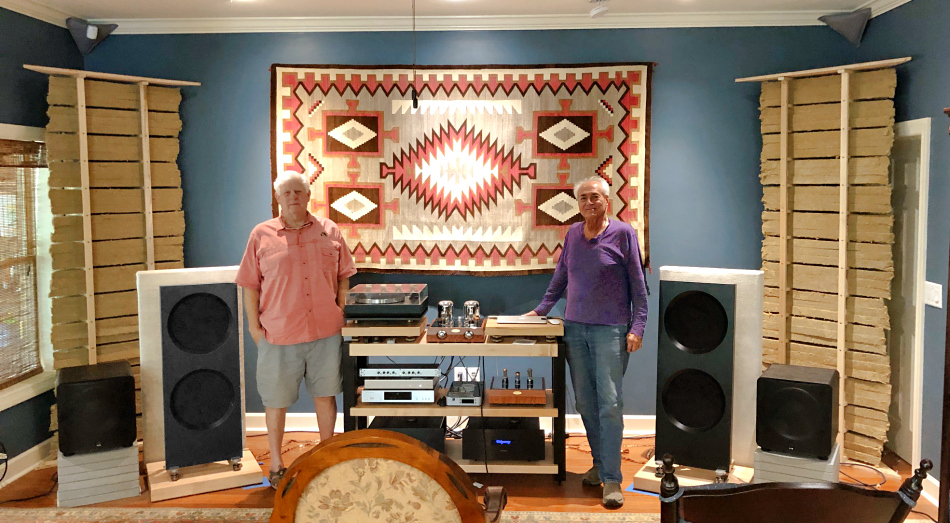 |
| Here it is again
"almost" finished. Notice the top pieces of plywood.
Yours truly is on the right. |
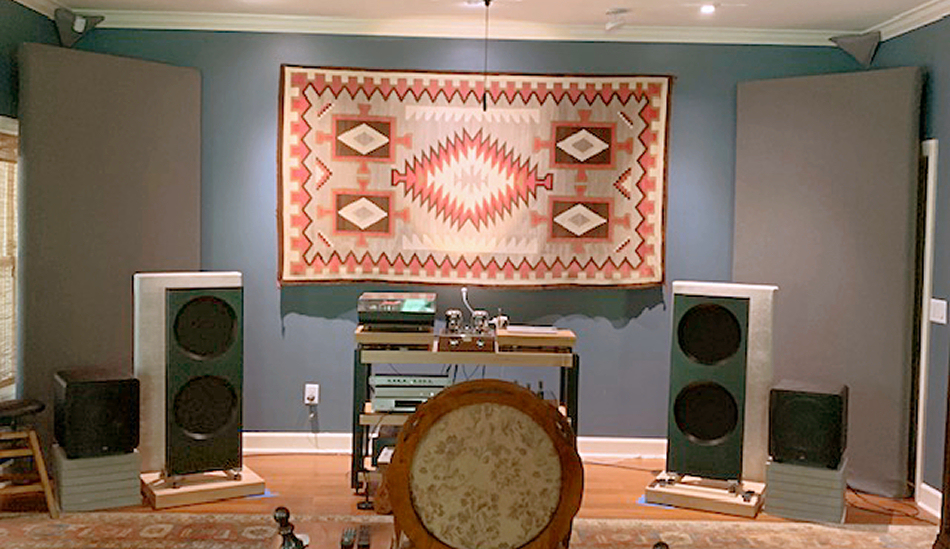 |
| ...and here it is finished! |
THE SPEAKERS
These are Spatial Speakers. The top 12" driver is a dual concentric with a tweeter section in the middle. Once I tamed them, they are magnificent. The first issue is I don't particularly like dipoles or the 'bose effect'. Soon there will be a long and comprehensive white paper as to why this mostly doesn't work, but remember in audio, everything tugs on everything else. You CANNOT get clean impulse response at a particular listening position with dipoles - in effect, you are trying to reproduce a recorded acoustic space in your own acoustic space, and your ears are too smart for that. That's one reason (of quite a few) why it never really sounds like a piano, it always sounds like a recording of a piano.
If you like to sit in one place and concentrate and listen, and razor sharp holographic imaging is important to you, then you don't necessarily want dipoles. If you prefer to sometimes stand, sometimes sit, sometimes wander around the room, etc then you will probably like the spaciousness and openness - but the imaging will often be "odd".
So in this instance since the customer already had those simple absorbent "panels" I decided to place them behind the mains to MOSTLY soak up the back wave. Since the top driver is concentric there's no tweeter HF splay going backwards - only everything below the XO point of the tweeter behaves like a dipole, or to put it another way, the drivers are mounted 'infinite baffle'.
THE TWEETERS
First we have to correctly place and aim the speakers. Using my white noise test we find out that because of the entire ELECTRO-MECHANICAL PHENOMENA of each exact driver, one of them was splaying the highs a little higher than the other, and at a slightly different angle.. You will find that almost no speaker box or even concentric driver (except for the KEF UniQ, and some Tannoy concentrics) splays evenly. We have found that some ceramic drivers splay very UNevenly. For example, it "seems" as if the freqs around 3k are going off in one direction, and the freqs around 6k are splaying off in another direction, and 10K+ is going off in another direction. Very annoying. But unless you take the time and patience to try these UNIQUE tests, you will never be able to discern that, let alone try to optimize it in your room.
The concept is to aim that white noise critically toward your face. By toeing the speakers in a little, you are also NOT sending HF toward the side walls so much. Follow my Test CD instructions to the letter and carefully.
This is NOT a 10 minute process. Once you THINK you have measured with a tape measure, throw the tape measure away - you are usually NOT EVEN CLOSE. You MUST finish the aiming and positioning (toe-in angle, tilt forward or back angle) with white noise. With the out-of-phase white noise track, eventually you will find a rather sharp null at your listening position when you move your head back and forth.
It will never REALLY
null or disappear, because of 2 things:
1) The frequency response of EACH driver is different,
often +/- 2,3,4,5 dB AT EACH CYCLE (!) Therefore at 6000 Hz it might
be 0dB, at 6004 Hz +2 dB, at 6008 Hz -2 dB, and so on. If they (the
sales and marketing weenies) didn't smooth the response charts you
would never buy anything...
2) The percentage of slop in your passive crossover parts,
especially capacitors.
You can only null noise like this out completely and perfectly in an electronic circuit, like a mixing board, but because of the vagaries of the passive crossover components, and the drivers themselves, it'll never REALLY work - but don't think for a moment it isn't worth it. This is one of the two most important setup tools you have. And while we're at it, please buy my Test CD. www.soundoctor.com/testcd which contains the bit-accurate out-of-phase white noise tracks you must use.
IMAGING AND SOUNDSTAGE
EVENTUALLY you will get the imaging where you like but then you have to contend with the so-called SOUNDSTAGE. Let's say we play a nice performance of a female vocalist, like the Holly Cole I suggest on my CD. So she SHOULD seem to be in the center (of course), but YOU will have to discern is she in the center or seemingly in front of the speaker line, or behind the line? As you play different presumably well recorded Jazz selections, you should get a feel for the so-called soundstage. This is where the splayed angle of your mains becomes important. I find that the 60 degree angular separation is often not quite enough - you might find if you move your mains 6" further apart the soundstage gets to where you PERCEIVE it to be correct. But IF you move the mains in any direction, you must refocus the white noise null. If you have an assistant, this is NOT a scenario where two guys mess around for a few minutes then run off and have a beer. I have spent 2 full days+ on this critical aiming and the results are thrilling.
Some brands of speakers have stunning TIMING between the drivers. For example, KUDOS to Rockport speakers - the drivers are mounted on a curved surface, and yet when you play white noise it is a flawlessly coherent "apparition" out in space. The same for M&K's. Notice with the M&K 150 or 300 models the tweeters are in a straight line... but put a string on the end of your nose and draw a tangent curve at the speaker and you will see that the center tweeter is too close to you. Therefore the crossover has to delay that center tweeter so the short wavelengths of high frequencies from the three tweeters converge out in space where you are sitting. To be used as nearfield monitors, a speaker should do this at about 18" or so and the phase alignment should be valid up to about 8 feet. Beyond that distance, it doesn't matter any more because of air flow in the room, temperature variations, and your head movements. But when you play WHITE NOISE (NOT PINK!) and move your head around to determine the splay from the entire speaker cabinet, if it doesn't seem perfectly even then the manufacturer hasn't done their job. Or as is most likely, they incorrectly obsessed about frequency response instead of phase response...
THE SUB PHASE ADJUSTMENT
Since we want to match the sub phase correctly, we MUST soak up that LF back wave because it will leave the back of the mains, travel 3.5' to the wall, bounce back, and now BY THE FRONT OF THE SPEAKERS we will have a reflected smearing wave that's 7msec late, from the bottom of the tweeter freq all the way down to the top of the SUB XO freq. Not good. This is also going to put somewhat of a cancellation null at around 155 Hz, because of the "Allison Effect".
The subs this customer bought are SVS SB 3000's, which DO come wth a nice APP for your phone. I decided to XO at 90. Because of these new bass traps the low freqencies in the room from 60 down to about 18 are astonishingly EVEN. So by raising the subs up to the height of the mains LF driver, this is just enough to change the modal coupling in the room enough to help focus the stomach and chest slam, at the very slight expense of LESS coupling around 20-28.
So let's for the moment talk about dual subs. If someone owns 2 subs, you can put them either in the 2 'good' spots where they belong; at one good spot "next" to each other, or at one good spot "one on top of the other" - like the JL Audio f212, Gotham G213, and such. The idea is that the lower driver couples the lowest bass freqs better into the room, (think 20-40 Hz "LFE" noises in Sci-Fi movies) while the higher driver is at enough of a height difference to be at a different modal coupling spot, therefore couples the more musical bass freqs (40-90) better to your stomach and chest. This is where the "slam" focus comes from.
IF the subs are in their 2 separate good spots (what nearly everyone does) fine; you can get about 3-4 dB more HEADROOM, since you will of course adjust the subs for the correct finished level.
If the subs are NEXT to each other, you will get up to 6 dB coupling (and therefore headroom).
If one is on top of the other, you will get 4-5 dB more headroom.
THE CROSSOVER
The customer did not want to get the JL Audio CR1 (which was my science project...) just yet, so he elected to get the dbx 223s - a stunning deal at ballpark $175. IF you insist on using balanced XLR cables you can get the 223XS. This XO HAS phase flipper switches so when you are doing the sine wave phase cancellation AT the XO freq, you don't need to switch the actual wires around on the back of your speakers (or amp).
THE SVS SUB
Now the SVS 3000... NEVER buy a ported sub for your living room! Never! Please read my subs white paper !
This sub comes with a fantastic phone APP so you can sit AT YOUR CHAIR and adjust the phase null.
But as they say about relationships... it's complicated.
First, and APPLE, YOU CAN LEARN FROM THIS, you can hit / tap the little triangles at the endpoints to walk the settings up or down 1dB at a time, so forget the fat fingers dragging the orange circle thing. Wonderful!
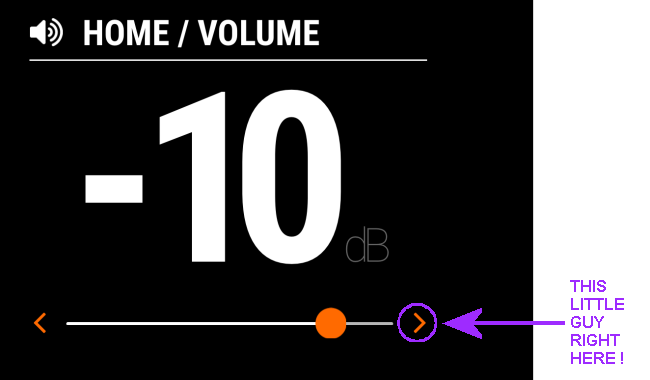 |
| Wake up Apple!!! |
It does this smoothly. HOWEVER, here comes the complicated part. When you are setting the PHASE setting, you have to wait for the app to UPDATE it's delay each step which takes about a second. So IF your net result is going to be, say, 140 degrees, it's going to take you about 3 minutes to get there, one degree at a time. You can't move it fast or you'll never find the null. However this is far easier than enlisisting an assistant to turn knobs while you say, "...up, up, up, stop, down, down down, no up, up... no stop no wait, down a little..." At least with JL Audio Fathom subs the knobs are on the front, so far easier than trying to crouch down behind a sub and tweak a knob in 1mm steps...
When you are nulling the levels AND the phase have to be exactly correct and the depth of the null will astonish you. IF your room has NO acoustic treatment, and therefore you have bass reflecting all over the place, the null or nulls will be somewhat more vague. In this particular room, because of the bass traps, (and the gentle absorption behind the mains) the null was almost totally deep - like 50 dB down. The null is 1dB wide and 1 DEGREE (on the scale) wide!
So what does that really mean? At 90Hz the period of the waveform is 11msec. Therefore 1/360th of that (1 degree on the dial) is 30 usec (30 microseconds)!
In terms of distance, if the wavelength is about 12.5 feet, that's 150 inches, so each degree of phase adjustment is essentially electrically moving the waveform back and forth in space a little less than an inch.
When you're doing this, you ALSO have to do the entire test with the POLARITY SWITCH on the sub set the other way. THEN ALWAYS choose the null that results in the lowest number OF DEGREES ON THE SCALE, no matter which way the polarity switch is set.
In doing all this for years, I find the customers often have to re-evaluate their listening positions, AND chairs! IF you want great audio DO NOT BUY one of those awful home theater chairs - it will soak up and block the bass. Yes if you intend to buy a soft recliner type, perhaps with an ottoman, that's fine. Do not get a chair where the headrest is up too high - it will reflect the highs behind your head and not help the imaging.
This customer experimented by getting a furniture dolly at harbor freight (the wheels did not rotate - they only moved forward and backward) and moving his chair forward and back until he felt comfortable with the "feeling of the imaging" and THEN we did the white noise null.
And after a few tightening-up iterations, and AFTER the sub phase is set razor sharp, you should start to perceive VERTICAL imaging. Sure, sure, it can't be done, naysayers believe. If you have speakers with the tweeter on top (not the incorrect MTM thing) you SHOULD be very pleasantly surprised. Once everything above 2k is phase aligned things should start being the correct "size" AND height. Wait till you experience it! And note that it may take a few entire iterations of tightening all of this up before you get there.
Now there MIGHT be a problem with a particular brand or model of speaker you are using. Sadly, most mfgs until recently were obsessed with freq reqponse and paid rather little attention to the phase response IN FRONT of the cabinet. More on this phenomena as I have discovered it in further systems, on the other projects pages.
Notice up until now I haven't mentioned the electronics. This customer has a strangely interesting preamp - the Supratek from Australia, here: www.supratek.com.au and the power amps are Klauss Bunge's Odyssey Kismet monoblocks, here: www.odysseyaudio.com/products-kismet-reference-amplifiers.html
So SINCE the subs are handling the bass, the mains are LOAFING ALONG and they "seem" as if they have infinite headroom. This system will easily play anything you throw at it at any level - we were playing my Techmaster PEB killer bass test tracks at 120 dB. Also, since the mains are not being stressed with bass - and subsequently NOT doppler modulating everything ABOVE the now chosen 90 Hz XO freq, everything is fantastically clean and, as the customer says, "in its place'.
|
|||
| There is no plug-in for experience... | |||
| SOUNDOCTOR BARRY OBER EMAIL: barry@soundoctor.com | |||